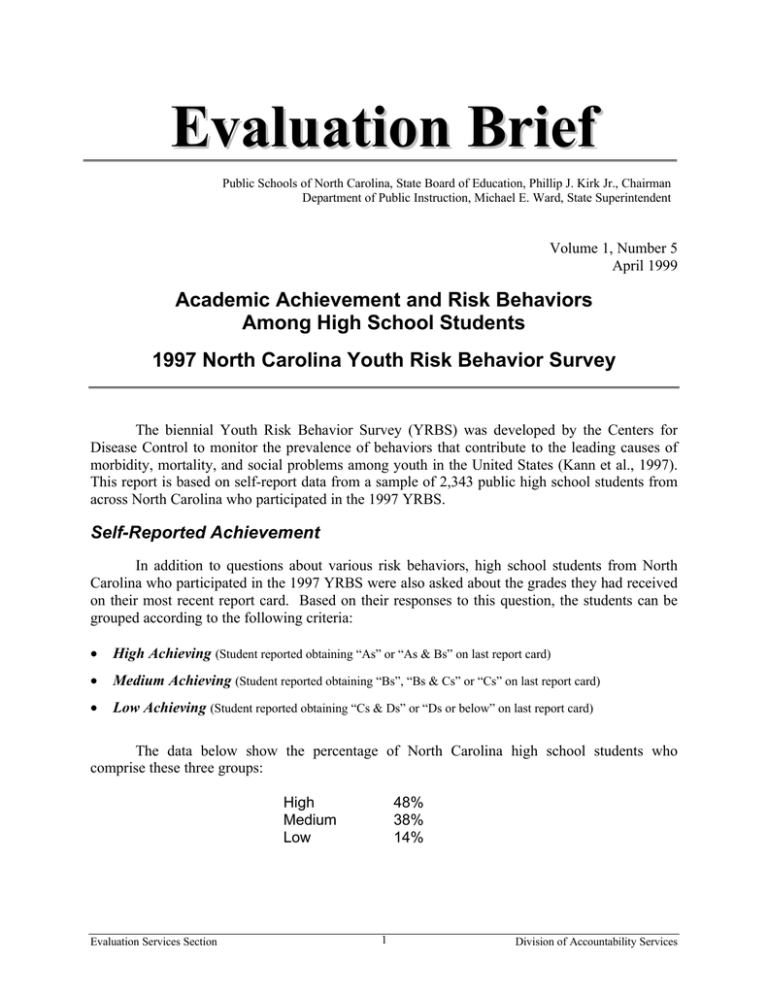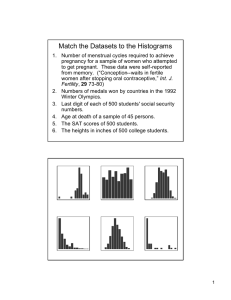
Evaluation Brief
Public Schools of North Carolina, State Board of Education, Phillip J. Kirk Jr., Chairman
Department of Public Instruction, Michael E. Ward, State Superintendent
Volume 1, Number 5
April 1999
Academic Achievement and Risk Behaviors
Among High School Students
1997 North Carolina Youth Risk Behavior Survey
The biennial Youth Risk Behavior Survey (YRBS) was developed by the Centers for
Disease Control to monitor the prevalence of behaviors that contribute to the leading causes of
morbidity, mortality, and social problems among youth in the United States (Kann et al., 1997).
This report is based on self-report data from a sample of 2,343 public high school students from
across North Carolina who participated in the 1997 YRBS.
Self-Reported Achievement
In addition to questions about various risk behaviors, high school students from North
Carolina who participated in the 1997 YRBS were also asked about the grades they had received
on their most recent report card. Based on their responses to this question, the students can be
grouped according to the following criteria:
•
High Achieving (Student reported obtaining “As” or “As & Bs” on last report card)
•
Medium Achieving (Student reported obtaining “Bs”, “Bs & Cs” or “Cs” on last report card)
•
Low Achieving (Student reported obtaining “Cs & Ds” or “Ds or below” on last report card)
The data below show the percentage of North Carolina high school students who
comprise these three groups:
High
Medium
Low
Evaluation Services Section
48%
38%
14%
1
Division of Accountability Services
Self-Reported Achievement and Demographic Characteristics
The following tables describe the gender, ethnicity, and grade level of the students who
are classified as high, medium, and low achieving based on the 1997 YRBS data. Among high
school students, students whose self-reported achievement is in the “low” category are somewhat
more likely to be male. Hispanic students are also over-represented among low achievers, while
Asian/Pacific Islanders are significantly under-represented. Fewer students reporting low grades
are found in the 12th grade, perhaps a reflection of lower-achieving students dropping out during
high school.
Gender
Female
Male
High
56%
39%
Medium
33%
43%
Low
11%
18%
Total
100%
100%
Overall Sample
48%
38%
14%
100%
Ethnicity
Black
White
Hispanic
Asian/Pacific
Native American/Alaskan
Other
High
38%
53%
41%
62%
41%
46%
Medium
45%
34%
37%
35%
45%
38%
Low
17%
13%
22%
3%
14%
16%
Total
100%
100%
100%
100%
100%
100%
Overall Sample
48%
38%
14%
100%
Grade
9th
10th
11th
12th
High
46%
46%
46%
55%
Medium
37%
39%
39%
36%
Low
17%
15%
15%
9%
Total
100%
100%
100%
100%
Overall Sample
48%
38%
14%
100%
Evaluation Services Section
2
Division of Accountability Services
Self-Reported Achievement and Other Risk Behaviors
Research has linked a variety of risk behaviors with lower academic achievement,
including smoking (Bewley & Bland, 1977; Hover & Gaffney, 1988; Hu, Lin, & Keeler, 1998),
drug use and violent behavior (Beauvais, Chavez, Oetting, Deffenbacher, & Cornell, 1996;
Murguia, Chen, & Kaplan, 1998; Paulson, Coombs, & Richardson, 1990), drinking and driving
(Williams, Lund, & Preusser, 1986) and sexual activity (Brook, Balka, Abernathy, & Hamburg,
1994; Ohannessian & Crockett, 1993). The following charts based on 1997 YRBS data provide
a descriptive look at some potential relationships between self-reported academic achievement
and the prevalence of various risk behaviors among North Carolina high school students.
Vehicle Safety
Percentage of high school students who reported “never” or “rarely” wearing a seatbelt in a car
or a helmet while riding a motorcycle during the past year:
Seatbelt
Helmet (Motorcycle)
Percent of Students
70
60
50
40
30
20
10
0
High
Medium
Low
Self-Reported Grades
Percentage of high school students who reported that they had ridden in a car with a drinking
driver or drank before driving during the past month:
Ride w/ Drinking Driver
Drive While Drinking
70
Percent of Students
60
50
40
30
20
10
0
High
Medium
Low
Self-Reported Grades
Evaluation Services Section
3
Division of Accountability Services
Violence
Percentage of high school students who have been in a fight in the past 12 months, and
percentage of students who carried a gun or other weapon in the past 30 days:
Carry Weapon
Carry Gun
Been in Fight
Percent of Students
70
60
50
40
30
20
10
0
High
Medium
Low
Self-Reported Grades
Suicidal Behavior
Percentage of high school students who considered suicide, planned suicide, attempted suicide,
or were injured in a suicide attempt in the past year:
Considered Suicide
Attempted Suicide
Planned Suicide
Injured In Suicide Attempt
Percent of Students
70
60
50
40
30
20
10
0
High
Medium
Low
Self-Reported Grades
Evaluation Services Section
4
Division of Accountability Services
Tobacco Use
Percentage of high school students who reported that they had smoked a cigarette or used
smokeless tobacco in the past month:
Smoking
Smokeless Tobacco
Percent of Students
70
60
50
40
30
20
10
0
High
Medium
Low
Self-Reported Grades
Alcohol Use
Percentage of high school students who drank alcohol or engaged in “binge drinking” (having 5
or more drinks in a row) at least once in the past month:
Drinking
Binge Drinking
70
Percent of Students
60
50
40
30
20
10
0
High
Medium
Low
Self-Reported Grades
Evaluation Services Section
5
Division of Accountability Services
Other Drug Use
Percentage of high school students who reported using marijuana or cocaine in the past month,
and percentage of students who reported having ever used inhalants (such as glue, paint or spray
cans), hallucinogens, or speed:
Marijuana
Cocaine
Hallucinogens
Speed
Inhalants
Percent of Students
70
60
50
40
30
20
10
0
High
Medium
Low
Self-Reported Grades
Sexual Behavior
Percentage of high school students who reported having sexual intercourse before age 14, having
been involved in a pregnancy, and having been diagnosed with a sexually transmitted disease:
Sex Before 14
Pregnancy
STD
Percent of Students
70
60
50
40
30
20
10
0
High
Medium
Low
Self-Reported Grades
Evaluation Services Section
6
Division of Accountability Services
Percentage of high school students who reported having multiple sexual partners in the past 3
months, percentage of students who drank or used drugs prior to the last time they had sexual
intercourse, and percentage of students who failed to use contraception the last time they had
sexual intercourse:
Multiple Partners
Drink/Use Drugs Before Sex
No Contraception
Percent of Students
70
60
50
40
30
20
10
0
High
Medium
Low
Self-Reported Grades
Summary
Data from the 1997 Youth Risk Behavior Survey help to shed light on relationships
between academic achievement and other risk behaviors among North Carolina high school
students. Specifically, these data indicate that:
•
High school students who report that they received poor grades on their last report card are
more likely to be male and Hispanic.
•
High school students who report that they received poor grades on their last report card may
be more likely to engage in risk behaviors, including neglecting safe driving/riding practices,
fighting, carrying weapons, suicidal behavior, drug use, and risky sexual behavior.
In addition to focusing on academics, identification and remediation efforts targeting low
achievers may also need to consider behavioral risk factors which tend to co-occur with poor
school performance. While low achievement itself puts students at risk of school failure, lowachieving students who are also engaging in risky behaviors in the non-academic areas of their
lives will be at even greater risk for a variety of negative outcomes. For students who are
already struggling in school and/or engaging in risk behaviors, intervention efforts are likely to
be more effective if they address social and behavioral concerns as well as academics.
Evaluation Services Section
7
Division of Accountability Services
References
Beauvais, F., Chaves, E. L., Oetting, E. R., Deffenbacher, J. L., & Cornell, G. R. (1996).
Drug use, violence, and victimization among White American, Mexican American, and
American Indian dropouts, students with academic problems, and students in good academic
standing. Journal of Counseling Psychology, 43, 292-299.
Bewley, B. R., & Bland, J. M. (1977). Academic performance and social factors related
to cigarette smoking by schoolchildren. Journal of Epidemiology and Community Health, 31,
18-24.
Brook, J. S., Balka, E. B., Abernathy, T., & Hamburg, B. A. (1994). Sequence of sexual
behavior and its relationship to other problem behaviors in African American and Puerto Rican
adolescents. Journal of Genetic Psychology, 155, 107-114.
Hover, S. J., & Gaffney, L. R. (1988). Factors associated with smoking behavior in
adolescent girls. Addictive Behaviors, 13, 139-145.
Hu, T., Lin, Z., & Keeler, T. E. (1998). Teenage smoking, attempts to quit, and school
performance. American Journal of Public Health, 88, 940-943.
Kann, L., Kinchen, S. A., Williams, B. I., Ross, J. G., Lowry, R., Hill, C. V., Grunbaum,
J. A., Blumson, P. S., Collins, J. L., Kolbe, L. J., & State and Local YRBSS Coordinators.
(1998). Youth risk behavior surveillance – United States, 1997. Journal of School Health, 68,
355-369.
Murguia, E., Chen, Z., & Kaplan, H. B. (1998). A comparison of causal factors in drug
use among Mexican Americans and non-Hispanic Whites. Social Science Quarterly, 79, 341360.
Ohannessian, C. M., & Crockett, L. J. (1993). A longitudinal investigation of the
relationship between educational investment and adolescent sexual activity. Journal of
Adolescent Research, 8, 167-182.
Paulson, M. J., Coombs, R. H., & Richardson, M. A. (1990). School performance,
academic aspirations, and drug use among children and adolescents. Journal of Drug Education,
20, 289-303.
Williams, A. F., Lund, A. K., & Preusser, D. F. (1986). Drinking and driving among
high school students. International Journal of the Addictions, 21, 643-655.
Evaluation Services Section
8
Division of Accountability Services

